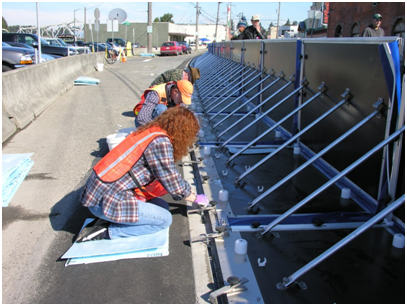Flood Barriers
Install Temporary Flood Barriers
What Is It?

AquaFence
Flood shields and other permanent flood barriers can be expensive to install and aesthetically displeasing. A wide range of temporary flood barriers are available as alternatives to traditional sandbags for building owners to set up quickly in preparation for a potential flooding event. A selection of the types of temporary flood barriers include:
- Inflatable flood barriers: Inflatable flood barriers are set up prior to a potential flood event and use incoming flood waters to inflate automatically and create a barrier to divert water.
- Membrane barriers: Membrane flood barriers use floodwater to seal and stabilize the groundsheet and backwall.
- Modular barriers: Modular barriers can be constructed of a wide range of materials and use floodwaters to deploy.
Compared to sandbags, most temporary flood barriers can be reused and easily deconstructed and redeployed for multiple flood events. In selecting a temporary flood barrier, it is important to consider the amount of setup time and labor needed to prepare the barrier in addition to factors like cost and protection. Some barriers can be set up by a few people in a short period of time (e.g. Floodstop), while others will require teams of 12 or more workers and several hours to set up (e.g. Aquafence). Depending on flood frequency and site conditions, it may be more cost effective in the long-term to install a permanent, in-situ flood barrier (see “Permanent Flood Barrier”). In addition, some of these permanent flood barriers do not require human intervention to setup and will automatically deploy.
Benefits
- Temporary barriers are reusable, easier to deploy and cleanup, and often cheaper than sandbags
- Temporary barriers do not require building or site modifications that may be costly or aesthetically displeasing
Drawbacks
- Models range in deployment time. Deployment requires human intervention and sufficient installation time for larger buildings. Without adequate warning, flooding can occur before shields can be put in place
- Most temporary barriers do not protect structures from high-velocity flooding and wave action.
- Can obstruct building access when deployed.
Regulatory Impacts and Requirements
Potential regulatory touchpoints in Boston and Massachusetts include:
- Fire Department
- Building Code/Permit
- Inspectional Services Department
NEWS
- "Lyndhurst Exploring Portable Barriers for Flood Prone Neighborhood" NorthJersey.com, October 2013
- "Possible Flood Solutions Explored in Mandeville" Fox8 Louisiana, October 2013
PROJECT EXAMPLES
- 2 Water Street, Manhattan, NY
- Grand Isle, LA (in response to Deepwater Horizon Oil Spill)
- Andover, UK


